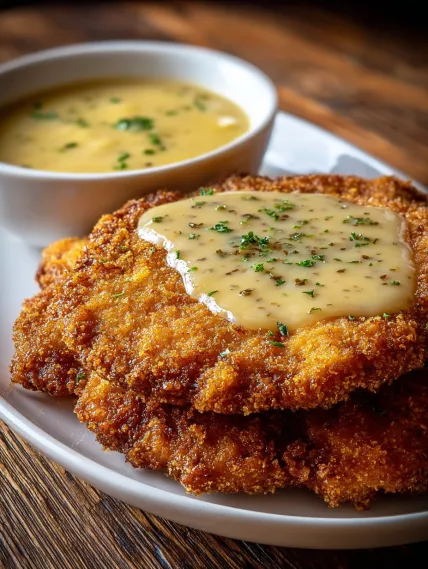 Pin
Pin
This buttermilk chicken fried steak transforms humble cube steak into crispy, golden perfection topped with creamy country gravy. The contrast between the crunchy exterior and tender meat creates that unmistakable comfort food experience that generations of Southern families have treasured for Sunday suppers and special occasions.
I discovered this recipe during my first winter in the Midwest when I was desperately missing my grandmother's Southern cooking. After several failed attempts with soggy coatings, this double dredging technique finally gave me that authentic crunch I remembered from childhood visits to my grandparents' farm.
Ingredients
- Beef cube steaks: already tenderized for convenience and faster cooking
- Buttermilk: provides tanginess and helps tenderize the meat while creating the perfect base for a flavorful crust
- Eggs: create binding power that ensures your coating adheres properly
- All purpose flour: creates the foundation for both the crispy coating and silky gravy
- Paprika: adds subtle color and mild sweetness to the coating
- Cayenne pepper: optional but recommended for a gentle heat that balances the richness
- Garlic powder and onion powder: provide savory depth without the texture of fresh aromatics
- Whole milk: creates a rich smooth gravy with perfect consistency
- Vegetable oil: with its neutral flavor and high smoke point perfect for achieving golden crispy coating
How To Make Crispy Buttermilk Chicken Fried Steak
- Prepare the steaks:
- Place steaks between plastic wrap and gently pound to even thickness of 0.5 cm. This critical step ensures even cooking and maximum tenderness. Season generously with salt and pepper on both sides allowing the seasonings to penetrate before coating.
- Create your dredging station:
- Combine buttermilk and eggs in one shallow dish beating until completely incorporated. In a separate dish combine flour with all seasonings whisking thoroughly to distribute spices evenly. Having these stations prepared before handling the meat keeps the process clean and efficient.
- Double dredge technique:
- First coat each steak completely in seasoned flour pressing gently to ensure coverage. Dip into buttermilk mixture allowing excess to drip off then return to flour mixture. Press firmly to create a substantial coating with craggy texture which creates extra crispy surfaces during frying.
- Perfect frying technique:
- Heat oil to approximately 350°F in heavy skillet. The proper temperature ensures immediate crust formation without oil absorption. Work in batches to prevent overcrowding which would lower oil temperature resulting in soggy coating. Fry until deeply golden brown approximately 3 to 4 minutes per side.
- Creating silky country gravy:
- Pour off most oil leaving browned bits fond in the pan. This fond contains concentrated flavor developed during frying. Add flour to remaining oil creating a roux and cook for exactly one minute to eliminate raw flour taste. Gradually whisk in milk allowing each addition to incorporate fully before adding more ensuring lump free gravy.
- Final assembly:
- Serve steaks immediately after frying topped with hot gravy. The contrast between crispy coating and creamy gravy creates the signature texture experience that makes this dish beloved across generations.

Watching my family dive into this dish reminds me of Sunday dinners at my grandmother's table. She always insisted on using cast iron for the perfect crust and would taste the gravy repeatedly claiming it needed more pepper though it was already perfectly seasoned. These little cooking rituals connect us to our culinary heritage in ways that transcend the simple ingredients.
Storage and Reheating
The chicken fried steak is best enjoyed immediately after cooking when the contrast between the crispy exterior and tender meat is at its peak. However if you need to store leftovers separate the steaks from the gravy and refrigerate them individually in airtight containers for up to 3 days. When reheating place the steaks on a wire rack over a baking sheet in a 350°F oven for 10 minutes to restore some crispness. Reheat the gravy separately in a saucepan over medium heat adding a splash of milk if needed to reach the desired consistency.

Regional Variations
This classic dish appears throughout the American South and Midwest with subtle regional differences. In Texas chicken fried steak typically features a thicker more substantial crust and peppered cream gravy. Oklahoma versions often incorporate more seasoning in the meat itself while some Arkansas cooks add a touch of hot sauce to the buttermilk mixture. These variations speak to the deep cultural significance of this humble yet beloved dish across different communities all united by the appreciation for transforming affordable cuts into satisfying meals.
Perfect Accompaniments
Chicken fried steak naturally pairs with classic Southern sides that complement its richness. Creamy mashed potatoes create the perfect base for catching extra gravy while buttered corn or green beans provide fresh contrast. For breakfast service pair with eggs and hash browns creating a hearty morning meal. Some Texan establishments serve their chicken fried steak with traditional Tex Mex accompaniments like pinto beans or salsa on the side demonstrating the fascinating cultural fusion that occurs in regional American cuisine.
Recipe FAQs
- → How do you ensure the steak is tender?
To ensure tenderness, gently pound the cube steaks to an even thickness of 0.5 cm and season with salt and pepper before coating.
- → What is the key to a crispy crust?
The double-dredging process—coating the steak in seasoned flour, then buttermilk, and again in flour—helps to create a crispy crust.
- → Can I make this dish spicy?
Yes, adding cayenne pepper to the flour mixture gives the crust a subtle heat. Adjust the amount to your spice preference.
- → What is the best oil for frying?
Use a neutral oil with a high smoke point, such as vegetable or canola oil, to ensure the crust fries evenly and doesn't burn.
- → How can I thicken the gravy?
For a thicker gravy, simmer longer while continuously whisking, or add a small amount of extra flour while cooking the roux.
